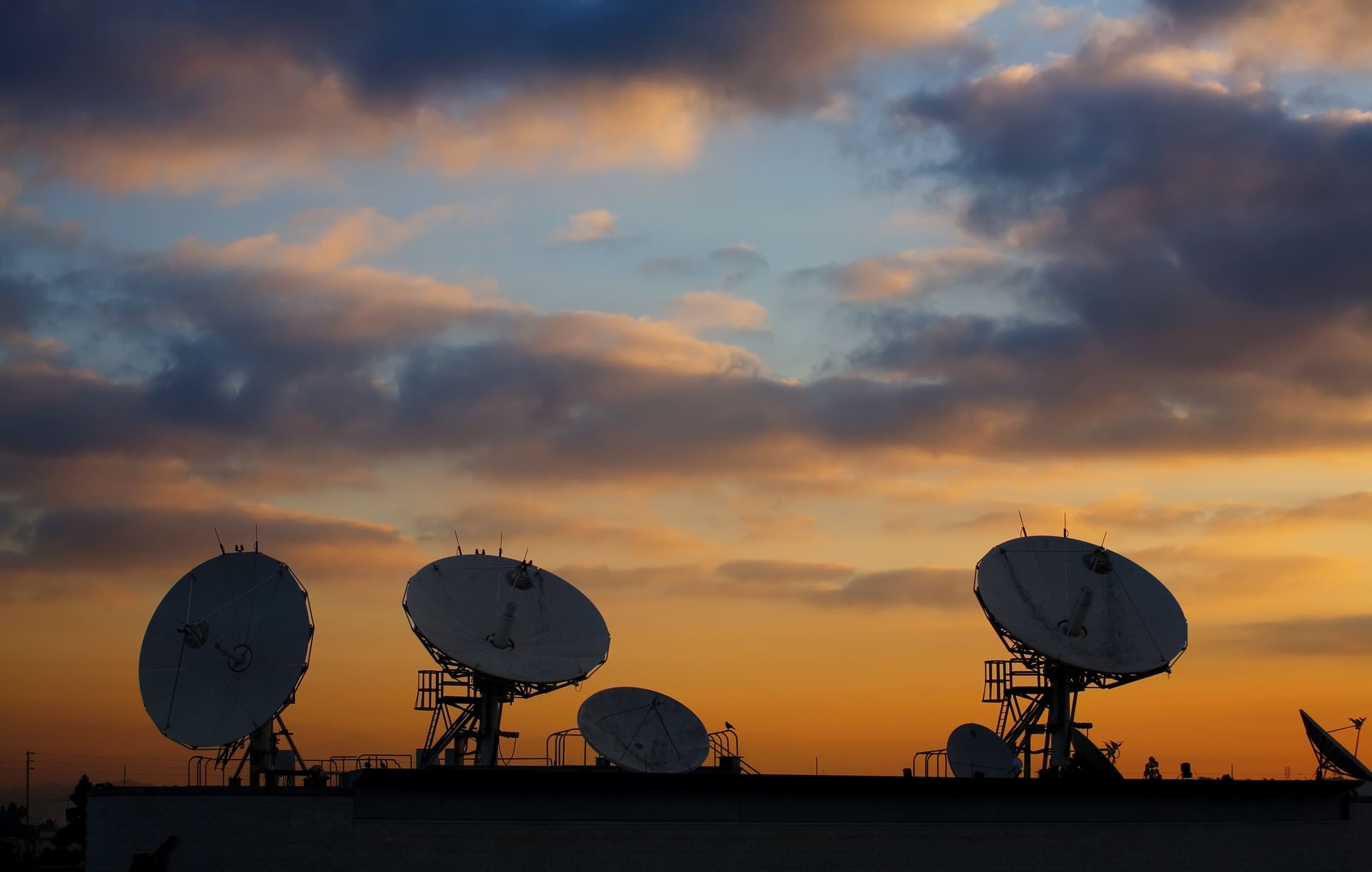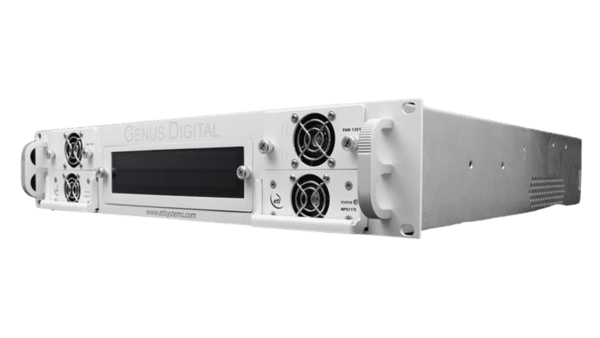
Digital IF
Revolutionising the Satcoms Industry
What is Digital IF?
Digital IF is the technology that bridges the gap between the traditional RF technology and the evolving cloud virtualised ground segment.
ETL’s GENUS DIGITAL plays a pivotal role in this transition by efficiently sampling analogue signals from diverse sources. These signals are then encapsulated as IP packets and transmitted over an ethernet connection, a process commonly referred to as ‘RF over IP’.
The signals are reconstructed at the receiving end, enabling seamless communication and data transfer between locations. This innovative approach not only streamlines signal transport but also facilitates the integration of traditional RF systems into modern digital infrastructures, marking a significant advancement in satellite communications technology.
Introducing
GENUS DIGITAL 5000

The satcoms industry is rapidly evolving to meet global connectivity demands and integrate smart satellite technologies. ETL Systems addresses this transformation with GENUS DIGITAL 5000, facilitating seamless synchronisation between analogue RF signals and the advancing digitised ground segment. This solution embraces a cloud-based ecosystem, offering unmatched flexibility, scalability, and operational agility to meet future needs.
GENUS DIGITAL 5000 supports diverse end-user applications by enabling dynamic adaptation of ground networks to sync harmoniously with space networks. This capability is crucial in the evolving landscape of global connectivity demands.
Engineered by ETL Systems, GENUS DIGITAL 5000 sets new benchmarks in satcoms by integrating analogue RF signals into a digital framework. This innovation enhances operational efficiency and performance, inviting clients to explore its transformative features through an exclusive trial program. This initiative underscores ETL Systems’ commitment to advancing satcoms technologies and meeting global client needs.
As a leap forward in satellite ground segment technology, GENUS DIGITAL 5000 reflects ETL Systems’ dedication to innovation and excellence. It ensures robust performance and reliability while setting new standards in connectivity, scalability, and operational effectiveness for satellite operators and service providers worldwide.
Featured Products
Features and Benefits of DIF

Resilience
IP addressing makes it easier to re-route signals in the digital domain.

Virtual Network Functions (VNFS)
DIF interfaces with hardware functions such as modems and spectrums analysers can be deployed virtually within the cloud, meaning these can be a OPEX rather than CAPEX.

Security
‘Behind the fence’ encryption ensures the security of both sensitive equipment, like encryption devices and modems, but also personnel. This is crucial when using an antenna in less secure countries, as Digital IF technology decouples the antennas from the coding equipment, enhancing overall safety.

Flexibility
Signal routing moves to the IP domain, making it modulation and encryption agnostic.

Signal Quality
Digitisation of the signal early in the RF chain guarantees preservation of signal quality, irrespective of the distance or the number of times the signal is split or rerouted.

Considerations to Keep in Mind
To fully leverage the potential of GENUS DIGITAL 5000, you will need access to an IP network with 100GBE Ethernet capability. This high-speed connectivity is essential to ensure seamless integration and optimal performance of GENUS DIGITAL 5000 in your operations.
Experience the Power of GENUS DIGITAL – Book Your Demo Today!
Discover how GENUS DIGITAL can revolutionise your RF distribution and signal management. Schedule a personalised demo with our experts to explore the full capabilities and benefits of our innovative solutions.

Digital IF Use Cases
Virtualisation
Digital IF technology will be a key enabler for digital modems – software or hardware based. It will provide operators with the flexibility to deploy new waveforms and, in conjunction with the implementation of virtual instruments, to monitor any signal from anywhere.

Diversity Antenna Sites
A Digital IF system protects against rain fade, atmospheric conditions and kinetic strike. It also allows transmission over 100s of miles without degradation regardless of the length of fibre or quality of RF cabling. Users will not need multiple fibre regeneration points to maintain signal quality.
This allows increased diversity antenna separation – key as satellite frequencies increase.

Non Geostationery Orbit (NGSO) Systems
The precise timestamping in the DIF system allows for exact handover points between antennas used for NGSO.
Precise time stamping can also be used for GEO-locating “interfering” signals, via Time of Flight (ToF) measurements.

Security Intelligence
The ability to geographically separate system elements with no impact on signal quality will enable ‘behind the wire’ encryption and reduce risk exposure. With fully remote system monitoring/control, only the antenna would be in the line of fire if located in a hostile territory.

Explore Key Insights in Digital IF Development: Download Now
This whitepaper explores the benefits of Digital IF, including support for digital modems, antenna diversity, and enhanced security. It examines the driving forces behind its development, and discusses the transition from analog to digital systems. The paper also highlights the importance of partnerships and interoperability in setting industry standards, and concludes with insights on measuring digital performance.
Register for an account or Login to view downloads

What’s Driving The Development of DIF?
The rapid expansion of IoT, with over 75 billion devices expected by 2025, is driving demand for efficient and scalable communication infrastructure. Current bandwidth limitations strain the ground segment, despite advancements in multi-orbit satellites, Wi-Fi, and 5G. Digital Intermediate Frequency (DIF) technology supports the transition to Ground Segment as a Service (GSaaS), offering flexible, virtualised infrastructure and reducing capital expenses. Major cloud providers like Microsoft Azure and Amazon AWS are key players in this digital shift, enabling secure, centralised data processing. This transition improves operational efficiency and security, as digital signals maintain quality over long distances and facilitate easier signal routing through IP networks.


Overcome Distance Limitations of Analogue RF Signals
Transitioning to digital doesn’t necessitate a complete overhaul at once. By adapting existing infrastructure, such as through ETL’s GENUS DIGITAL 5000, organisations can leverage Digital Intermediate Frequency (DIF) technology to convert analogue RF signals into digital forms. This approach minimises risk and maximises returns, allowing continued use of existing assets.
DIF enables digital signals to be securely transported globally via private IP networks, overcoming the distance limitations of analogue RF signals and ensuring signal integrity regardless of travel distance. It is also encryption and modulation agnostic, supporting various waveforms and making it versatile for different applications. While government and defence sectors are expected to lead in adopting DIF due to their stringent security needs, other industries may transition more gradually, balancing the use of both analogue and digital RF technologies. As DIF gains traction and proves its value, especially in high-security environments, we anticipate broader adoption and the development of a robust digitised ground infrastructure that will provide significant operational efficiencies and economies of scale.
Enhance Operational Security and Resilience
Digital IF is poised to revolutionise satellite communication across all sectors, with profound implications, especially in intelligence and government applications. By enabling the geographical separation of system components without compromising signal integrity, Digital IF facilitates robust ‘behind the wire’ encryption protocols, significantly mitigating risks associated with sensitive data transmission. This advancement ensures the uninterrupted operation of satellite networks, safeguarding both critical equipment and personnel from potential threats. Digital IF’s ability to maintain high signal quality over extended distances enhances operational security and resilience, making it indispensable for missions where confidentiality and safety are paramount concerns.


Remove Atmospheric Challenges with Digital IF
As satellite bandwidth demands escalate, pushing operations into higher frequency bands, atmospheric effects like attenuation during storms become more pronounced. In tropical regions, this can lead to up to 30dB of additional attenuation at Ka-band, a challenge exacerbated further in Q/V bands. To ensure continuous network availability, operators increasingly rely on spatial diversity.
Digital Intermediate Frequency (DIF) technology plays a crucial role by enabling transmission over extended distances without signal degradation, thus safeguarding against rain fade and other atmospheric disturbances. Moreover, Digital IF offers an advantage over RF-over-Fibre in diversity applications due to its precise GPS-disciplined timing, which inherently manages signal coordination without requiring compensation for fibre optic signal delays when switching between antenna sites. This capability enhances operational reliability and efficiency in satellite communications systems faced with dynamic environmental conditions and frequency challenges.
Improve Operational Flexibility Through Virtualisation
Supporting digital modems with Digital Intermediate Frequency (DIF) introduces a transformative shift from hardware-based to software-defined solutions, enhancing operational flexibility through virtualisation. Digital modems, hosted on standardised computing platforms, deliver substantial cost efficiencies compared to traditional hardware models. They enable seamless upgrades to the latest waveforms and accommodate fluctuating bandwidth demands, thereby converting modem expenditures from capital to operational expenses. The digital domain simplifies signal orchestration across the network, leveraging virtual instrumentation for streamlined management from any location. This evolution empowers operators with agile, cost-effective solutions capable of adapting swiftly to evolving communication needs.

What is the Difference Between Analogue and Digital IF?
Analogue IF signals fluctuate in amplitude over time and are prone to degradation during transmission, resulting in the need for signal conditioning to help compensate for losses over large distances. Digital IF, however, changes these signals into a digital stream, eliminating the need for signal conditioning and enabling signal transport over longer distances without analogue interference or losses.
Analogue signals are routed through Matrices. With Digital IF, the process becomes remarkably streamlined—simply a few clicks to alter the destination to a different IP address. This grants users operational flexibility, such as easy antenna changeover, with unprecedented ease and efficiency.

Transitioning to Digital IF
Transitioning to Digital Intermediate Frequency (DIF) begins with evaluating and enhancing your current infrastructure. ETL’s modular approach facilitates this shift by integrating existing analogue equipment, such as Matrices, RF over fibre, and frequency converters, with new DIF devices using the ETL Genus system. This system’s flexibility ensures that analogue components can work seamlessly with digital ones. Importantly, DIF is compatible with virtual modems that follow the DIFI interoperability standard. For legacy analogue modems, the ETL GENUS DIGITAL 5000 series acts as a bridge, converting these older systems to operate within the DIF framework. This integration requires robust high-speed networking—typically 100Gbe for core infrastructure and 10Gbe for edge devices—to support digital links effectively.

Adopting DIF through a hybrid approach allows for a smooth transition into the digital realm while preserving the advantages of RF technology. It’s crucial not to view DIF in isolation but as part of a broader ecosystem that includes strong RF performance. The modularity of ETL’s systems means that this ecosystem can evolve gradually, adapting at a pace that delivers sustained value. This approach balances the benefits of both digital and analogue technologies, ensuring that the transformation to DIF enhances overall system performance and operational efficiency.
How your Analogue Configuration Links to Digital
Transitioning from analogue to Digital IF requires a carefully planned and strategic approach. ETL’s GENUS DIGITAL solution offers a seamless integration path, facilitating the incorporation of analogue equipment such as Matrices, RF over Fibre systems, and Frequency Converters into a digital framework. This transition is made even smoother by the compatibility of Genus Digital with both legacy and virtual modems that adhere to the DIFI standard. By leveraging GENUS DIGITAL, organisations can simplify the migration process, optimise system performance, and pave the way for a fully digitalised operational environment.


The DIFI Standard
The Digital Intermediate Frequency Interoperability (DIFI) Consortium aims to facilitate digital transformation in satellite and related industries through a simple, open, and interoperable DIF/RF standard. This standard replaces the inherent interoperability of analog signals and helps prevent vendor lock-in. Unlike analogue RF, DIF is modulation agnostic and requires no signal conditioning for IP data streams. ETL Systems has been instrumental in developing this standard as a board-level member of the DIFI Consortium.
Agreed standards in DIF are crucial for sectors where communication integrity is vital. In the military, uninterrupted communication is essential for mission-critical updates. Similarly, reliable satellite signals are necessary for monitoring climate-related events such as tsunamis and hurricanes. In the commercial sector, satellites are fundamental for the connectivity of industries ranging from finance to retail. The digitization of these signals can enhance operational efficiency and productivity across these fields.
Interoperability through DIF is becoming more accessible, thanks to extensive research and development over the past two years. DIFI members are continuously shaping these standards to ensure future-proof, reliable products. This collaboration is crucial for achieving true interoperability in digital ground segment technology, enabling a seamless and efficient digital future for satellite communications.
Ensure that the virtual modem manufacturer you choose strictly follows the DIFI Standard to ensure compatibility and seamless integration within your system. By confirming their adherence to this standard, you can ensure a smoother transition and interoperability with Digital IF technology, thereby enhancing the overall efficiency and effectiveness of your system’s operations.
Are You Ready for Digital IF?
The transition to Digital IF marks a pivotal advancement in satellite communications, bridging the divide between analogue and digital systems while harnessing cloud technologies for unprecedented flexibility, scalability, and operational agility. This evolution signals a transformative era where hardware integration with cloud computing meets the dynamic needs of satellite communications.
Looking forward, the increasing importance of Virtual Network Functions suggests a promising future for Digital IF adoption in ground segment operations. Drawing from historical transitions, such as the shift from analogue to digital in television and telecommunications, provides valuable foresight into the profound impact Digital IF will have on satellite communications.
In summary, Digital IF stands poised to revolutionise ground segment operations and drive innovation and efficiency in satellite communications. With ongoing advancements in hardware capabilities and maturing cloud computing technologies, the journey towards a fully digitalised satellite infrastructure promises to push the boundaries of what’s achievable in space-based communication networks.
FAQS
Digital Intermediate Frequency (IF) is a key stage in the signal processing chain of modern communication systems, where an analog signal is converted into a digital format for easier processing. This involves down-converting the frequency of the signal to an intermediate frequency, digitising it using an analogue-to-digital converter (ADC), and then processing it with digital signal processing (DSP) techniques. This approach improves signal quality, reduces noise, and allows for more flexible and efficient processing.
Digital IF offers several advantages in communication systems, including:
– Improved Signal Quality: Digital processing reduces noise and distortion.
– Flexibility: Software-defined radio (SDR) can be implemented, allowing for easy updates and modifications.
– Integration: Simplifies the integration of multiple functions into a single chip, reducing hardware complexity.
– Cost Efficiency: Over time, digital components tend to be more cost-effective and reliable than analog counterparts.
– Advanced Features: Enables the use of sophisticated algorithms for better signal analysis and processing.
In radar systems, Digital IF enhances signal processing by:
– Precision: Providing higher precision and accuracy in signal measurements.
– Speed: Enabling faster processing speeds due to advanced digital algorithms.
– Range: Improving the detection range and resolution by minimising noise and enhancing signal clarity.
– Adaptability: Allowing for real-time adaptability and reconfiguration of radar parameters.
– Integration: Facilitating the integration of multiple radar functions on a single platform, which can reduce system size and power consumption.
The development of a Digital IF system requires several key components, including:
– Analog-to-Digital Converters (ADCs): To convert analogue signals into digital format.
– Digital Signal Processors (DSPs): For processing the digitised signals.
– Field-Programmable Gate Arrays (FPGAs): For implementing custom digital processing algorithms.
– Mixers and Oscillators: To down-convert the signal to the intermediate frequency.
– Software Tools: For designing and simulating the digital processing algorithms.
– Filters: To eliminate unwanted frequencies and noise before and after digitisation.
Implementing Digital IF technology involves several challenges, such as:
– High-Speed Data Conversion: Requires ADCs with high sampling rates and resolution.
– Signal Integrity: Maintaining signal integrity during high-speed processing.
– Processing Power: Demands significant processing power to handle complex algorithms in real-time.
– Thermal Management: Managing heat dissipation in densely packed digital components.
– Integration: Integrating digital IF with existing analogue systems without significant performance degradation.
– Cost: Balancing the cost of advanced digital components and the overall system budget.

Get in touch
Whether you’re starting a new project or need expert guidance, we’re here to find the perfect solution for your needs. Reach out to us now and start the conversation!



